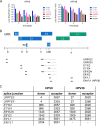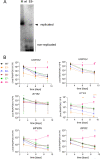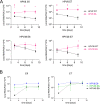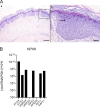Transcription Properties of Beta-HPV8 and HPV38 Genomes in Human Keratinocytes
- PMID: 36394329
- PMCID: PMC9749460
- DOI: 10.1128/jvi.01498-22
Transcription Properties of Beta-HPV8 and HPV38 Genomes in Human Keratinocytes
Abstract
Persistent infections with high-risk human papillomaviruses (HR-HPV) from the genus alpha are established risk factors for the development of anogenital and oropharyngeal cancers. In contrast, HPV from the genus beta have been implicated in the development of cutaneous squamous cell cancer (cSCC) in epidermodysplasia verruciformis (EV) patients and organ transplant recipients. Keratinocytes are the in vivo target cells for HPV, but keratinocyte models to investigate the replication and oncogenic activities of beta-HPV genomes have not been established. A recent study revealed, that beta-HPV49 immortalizes normal human keratinocytes (NHK) only, when the viral E8^E2 repressor (E8-) is inactivated (T. M. Rehm, E. Straub, T. Iftner, and F. Stubenrauch, Proc Natl Acad Sci U S A 119:e2118930119, 2022, https://doi.org/10.1073/pnas.2118930119). We now demonstrate that beta-HPV8 and HPV38 wild-type or E8- genomes are unable to immortalize NHK. Nevertheless, HPV8 and HPV38 express E6 and E7 oncogenes and other transcripts in transfected NHK. Inactivation of the conserved E1 and E2 replication genes reduces viral transcription, whereas E8- genomes display enhanced viral transcription, suggesting that beta-HPV genomes replicate in NHK. Furthermore, growth of HPV8- or HPV38-transfected NHK in organotypic cultures, which are routinely used to analyze the productive replication cycle of HR-HPV, induces transcripts encoding the L1 capsid gene, suggesting that the productive cycle is initiated. In addition, transcription patterns in HPV8 organotypic cultures and in an HPV8-positive lesion from an EV patient show similarities. Taken together, these data indicate that NHK are a suitable system to analyze beta-HPV8 and HPV38 replication. IMPORTANCE High-risk HPV, from the genus alpha, can cause anogenital or oropharyngeal malignancies. The oncogenic properties of high-risk HPV are important for their differentiation-dependent replication in human keratinocytes, the natural target cell for HPV. HPV from the genus beta have been implicated in the development of cutaneous squamous cell cancer in epidermodysplasia verruciformis (EV) patients and organ transplant recipients. Currently, the replication cycle of beta-HPV has not been studied in human keratinocytes. We now provide evidence that beta-HPV8 and 38 are transcriptionally active in human keratinocytes. Inactivation of the viral E8^E2 repressor protein greatly increases genome replication and transcription of the E6 and E7 oncogenes, but surprisingly, this does not result in immortalization of keratinocytes. Differentiation of HPV8- or HPV38-transfected keratinocytes in organotypic cultures induces transcripts encoding the L1 capsid gene, suggesting that productive replication is initiated. This indicates that human keratinocytes are suited as a model to investigate beta-HPV replication.
Keywords: HPV38; HPV8; beta-human papillomavirus; epidermodysplasia verruciformis; gene expression.
Conflict of interest statement
The authors declare no conflict of interest.
Figures






References
Publication types
MeSH terms
Substances
LinkOut - more resources
Full Text Sources

